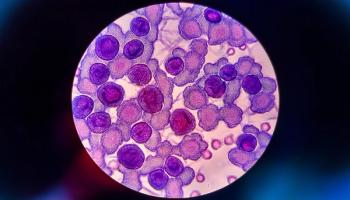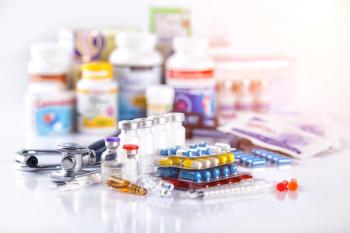
- August 2015 Pain Awareness
- Volume 81
- Issue 8
Edoxaban: A New Oral Factor Xa Inhibitor Anticoagulant
Edoxaban (Savaysa) has been approved for patients with atrial fibrillation.
Edoxaban (Savaysa) has been approved for patients with atrial fibrillation.1 Unlike warfarin, edoxaban is not metabolized by cytochrome P450 enzymes and is less susceptible to drug or disease interactions. Because it is primarily eliminated by the kidneys, reduced renal function will result in drug accumulation. Therefore, dose reductions are suggested in patients with renal dysfunction. The Table1,5,6 summarizes interaction studies reported with edoxaban.
Edoxaban’s bioavailability is approximately 60% and is unaffected by meals. Only a small amount of edoxaban is metabolized via carboxylesterase 1 and CYP3A4. Unchanged edoxaban is eliminated via renal (~35%), biliary, and intestinal (~65%) excretion.2 In subjects with renal dysfunction (creatinine clearance [CrCl] between 30 and 50 mL/ min), the area under the concentration time curve (AUC) of edoxaban increased 35% to 60%.3 The manufacturer recommends reducing the dose by 50% in patients with a CrCl between 50 and 15 mL/min. Edoxaban is a substrate of P-glycoprotein (P-gp), but not of other transporters.
Drug Interactions
Pharmacodynamic Interactions
Edoxaban administered alone prolonged bleeding time 20% to 35%. The addition of 100 or 325 mg of aspirin or 500 mg of naproxen resulted in a 2-fold increase in bleeding time compared with edoxaban alone.4 This increase is likely due to the combined effects of factor Xa and platelet inhibition by edoxaban and aspirin or naproxen, respectively. Combinations of edoxaban and other antiplatelet drugs would be expected to increase bleeding times. The 325-mg dose of aspirin was noted to increase the mean AUC of edoxaban by 30%. The mechanism of this increase is unknown.
P-Glycoprotein—Based Interactions
As expected, P-gp inhibitors— including amiodarone, cyclosporine, dronedarone, erythromycin, ketoconazole, quinidine, and verapamil—increase the AUC of edoxaban by up to 90%. Other P-gp inhibitors—including diltiazem, itraconazole, clarithromycin, grapefruit juice, propafenone, and ritonavir— will likely increase the AUC of edoxaban in a similar manner. Currently, the manufacturer of edoxaban does not recommend a dose adjustment when P-gp inhibitors are coadministered, even though the increases in edoxaban plasma concentrations may exceed the degree of increase that triggers a dose reduction recommendation in patients with renal dysfunction.
Rifampin, a P-gp inducer, decreases the AUC of edoxaban by about 35%. Doses of edoxaban will likely require an increase during concurrent rifampin administration. St. John’s wort and carbamazepine may also reduce dabigatran concentrations.
Clinical Significance
Patients stabilized on edoxaban should be monitored for altered response (bleeding or loss of anticoagulant effect) if P-pg inhibitors or inducers are added or removed from their drug regimen. The administration of other anticoagulants or antiplatelet drugs would be expected to increase the risk of bleeding in patients taking edoxaban. Patients with a prior history of bleeding, gastrointestinal ulcer, or hematologic abnormalities are likely to be at an increased risk.
Drs. Horn and Hansten are both professors of pharmacy at the University of Washington School of Pharmacy. For an electronic version of this article, including references, visit
References
- Savaysa [package insert]. Parsippany, NJ: Daiichi Sankyo, Inc; 2015.
- Bathala MS, Masumoto H, Oguma T, He L, Lowrie C, Mendell J. Pharmacokinetics, biotransformation, and mass balance of edoxaban, a selective, direct factor Xa inhibitor, in humans. Drug Metab Dispos. 2012;40(12):2250-2255. doi: 10.1124/dmd.112.046888.
- Jonsson S, Simonsson US, Miller R, Karisson MO. Population pharmacokinetics of edoxaban and its main metabolite in a dedicated renal impairment study. J Clin Pharmacol. 2015. doi: 10.1002/jcph.541.
- Mendell J, Lee F, Chen S, Worland V, Shi M, Samama MM. The effects of the antiplatelet agents, aspirin and naproxen, on the pharmacokinetics and pharmacodynamics of the anticoagulant edoxaban, a direct factor Xa inhibitor. J Cardiovasc Pharmacol. 2013;62(2):212-221. doi: 10.1097/FJC.0b013e3182970991.
- Mendell J, Zahir H, Matsushima N, et al. Drug-drug interaction studies of cardiovascular drugs involving P-glycoprotein, an efflux transporter, on the pharmacokinetics of edoxaban, an oral factor Xa inhibitor. Am J Cardiovasc Drugs. 2013;13(5):331-342. doi: 10.1007/s40256-013-0029-0.
- Mendell J, Chen S, He L, Desai M, Parasramupria DA. The effect of rifampin on the pharmacokinetics of edoxaban in healthy adults. Clin Drug Investig. 2015. doi: 10.1007/s40261-015-0298-2.
Articles in this issue
over 10 years ago
Generic Product News (August 2015)over 10 years ago
Benign Breast Diseases Associated with Thyroid Disordersover 10 years ago
Breast Cancer Survival Improved by 2 Drug Classesover 10 years ago
Intravenous Lidocaine May Prevent Chronic Pain After Mastectomyover 10 years ago
Pain Management: Aisle 4over 10 years ago
Case Studies (August 2015)over 10 years ago
Can You Read These Rxs? (August 2015)over 10 years ago
Pet Peeves (August 2015)Newsletter
Stay informed on drug updates, treatment guidelines, and pharmacy practice trends—subscribe to Pharmacy Times for weekly clinical insights.

















































































































































































































